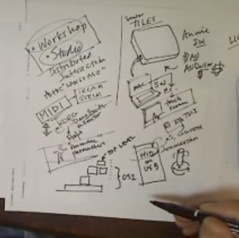
Workshop at TEI 2015, Friday 16 January 2015
Participation: We welcome all involvement!
Imagine walking into a room and being able to access all the parameters of the space (light levels, colours, temperature, music, video, etc.) from your own personal interface. The room will present all its parameters (and the ranges of each) to your personal interface device, which you can then map to the individual sensors on your device.
An interactive infrastructure allows people to have access to the parameters of an interactive environment in real time, potentially leading to an increased productivity, decrease of energy and material consumption, and generally greater satisfaction and experience. However, there is a need for a universal communication language between the elements of such an infrastructure. A language for the Internet of Things, media content, and people.
The workshop will bring together a number of participants from the field of Tangible and Embedded Interaction, who have ideas, insights and experience in developing communication languages. Rather than a symposium or mini-conference format, the format for the day is that of a working group consisting of selected experts and contributors. This working group will establish the groundwork for the interactive infrastructures language.
The aims of this workshop are to investigate and design new ways for interacting with the infrastructure of the built environment, and to research and develop the basis for an interactive infrastructure communication language which enables the distributed elements of the infrastructure to communicate with each other and with the environment. The effectiveness of infrastructures in buildings can be significantly improved with this approach.
The emphasis is on the physical interaction between people and their electronic environment, including tangible, wearable, gestural and spatial interfaces. The approach is to take frameworks for analysing physical and tangible interaction as a starting point, rather than technological factors. The first proposal is to start from the movements of people, described in Degrees-of-Freedom, and for each DoF describe the range, precision and haptic feedback.
A number of communication protocols already exist, from various industries (building, lighting, music) and research projects. Rather than replacing these, it is proposed that the interactive infrastructure language relates to all these existing standards.
The major part of the day will be used to explore the field and to establish common grounds for developing a standard for communicating between the elements of the interactive environments. We propose a hands-on approach, by exploring the needs and possibilities by actually experiment with connecting the devices that participants bring (actual products, prototypes, and demonstrators) in an ad-hoc version of the network protocol.
It is proposed that this will be presented to the TEI community in an informal 'jam-session', demonstrating an interactive infrastructure.
Further background can be found in a working document (based on a recent journal publication) which can be found here.
Organiser / facilitator:
A/Prof Bert Bongers
Faculty of Design, Architecture and Building
University of Technology Sydney, Australia
email: bertbon@xs4all.nl
Depending on the nature and quality of the submissions the workshop material will be submitted to a journal or publisher we regularly work with (CRC Press, IGI Global, Springer).
Program:
9:00 - 9:30 presenting background and aims and objectives for the day, and short introduction by all participants
9:30 - 10:30 informal presentations by each of the participants about their work in this area and their contribution to the development of a language for distributed interfaces
10:30 - 11:00 coffee break
11:00 - 12:30 continuing the presentations, and discussion on establishing the approaches and criteria for the communication language
12:30 - 2:00 lunch break
2:00 - 2:45 scoping session: drafting all the real world parameters - starting from what participants bring, organise in structure (taxonomy), cover multiple modalities.
2:45 - 3:30 discuss technical factors (resolution, speed), establish relations to other existing protocols
4:00 - 5:00 social issues to address, such as social relationships, level of individual access privileges, other issues as established during this workshop, develop scenarios
5:00 - 6:00 develop (hack) demonstrator jam-session, if appropriate
6:00 - 8:00 reception, present demonstrator
Workshop Participants:
Jamie Allen, IXDM Critical Media Lab (Basel) / (CIID) Copenhagen Institute of Interaction Design
Michel Beaudouin-Lafon Université Paris-Sud
Ali Mazalek, Ryerson University & Georgia Tech
Jeffrey Nichols, Google
Andreas Paepcke, Stanford University
Jessica Rajko, Arizona State University
Deborah Turnbull Tillman, Creative Robotics Lab UNSW, Sydney
Thanks to the following people for advice, feedback and support: Prof. Berry Eggen (TU Eindhoven), Prof. Kas Oosterhuis (TU Delft and ONL), Dr. Andrew Johnston (UTS Sydney), Dr. Lian Loke (University of Sydney), Mr. Stefan Lie (UTS), A/Prof Elise van den Hoven (UTS / TU Eindhoven), Dr. Bill Verplank (Stanford Unversity), A/Prof Ali Mazalek (Georgia Tech & Ryerson), and many others.

Background image credit: LaceScape (textile pattern by Cecilia Heffer)